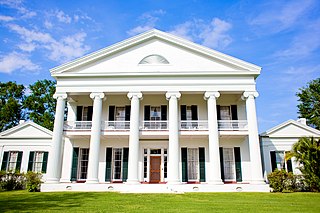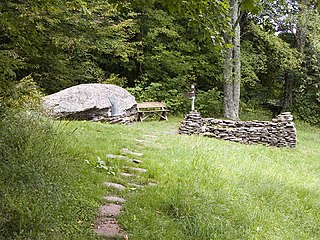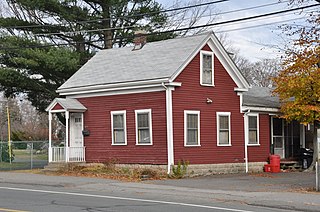
Madewood Plantation House, also known as Madewood, is a former sugarcane plantation house on Bayou Lafourche, near Napoleonville, Louisiana. It is located approximately two miles east of Napoleonville on Louisiana Highway 308. A National Historic Landmark, the 1846 house is architecturally significant as the first major work of Henry Howard, and as one of the finest Greek Revival plantation houses in the American South.

Woodchuck Lodge is a historic house on Burroughs Memorial Road in a remote part of the western Catskills in Roxbury, New York. Built in the mid-19th century, it was the last home of naturalist and writer John Burroughs (1837-1921) from 1908, and is the place of his burial. The property is now managed by the state of New York as the John Burroughs Memorial State Historic Site, and the house is open for tours on weekends between May and October. The property is a National Historic Landmark, designated in 1962 for its association with Burroughs, one of the most important nature writers of the late 19th and early 20th centuries.

The Josiah Bartlett House is a house in Kingston, New Hampshire. The 2+1⁄2-story wood-frame house is located on Main Street, opposite Town Hall. The main block of the house, five bays wide and three deep, was built in 1774 by Josiah Bartlett, replacing a house which was destroyed by fire. During the first decades of the 19th century, Greek Revival styling was added to the house, as was a two-story addition to the rear. The Greek Revival elements include large corner pilasters, projecting lintels over some of the windows, and the front door surround, which has pilasters and a cornice.

The Matthew Thornton House is a historic house and National Historic Landmark in Derry, New Hampshire. It was from 1740 to 1779 the home of Matthew Thornton, a signer of the U.S. Declaration of Independence.

Andalusia, also known as the Nicholas Biddle Estate, is a historic mansion and estate located on the Delaware River, just northeast of Philadelphia, in Bensalem Township, Bucks County, Pennsylvania. The community surrounding it, Andalusia, takes its name from the 225-acre estate.

Courthouse and Lawyers' Row is a National Historic Landmark District in the center of Clinton, Louisiana. Encompassing the individually listed East Feliciana Parish Courthouse and a series of five law office buildings located 12216 to 12230 Woodville Road, it represents a unique assemblage of law-related high quality Greek Revival buildings. It was added to the National Register of Historic Places and declared a National Historic Landmark on May 30, 1974.

The Playmakers Theatre, originally Smith Hall, is a historic academic building on the campus of the University of North Carolina at Chapel Hill. Built in 1850, it was designated a National Historic Landmark for its architecture, as an important example of Greek Revival architecture by Alexander Jackson Davis. It is now a secondary venue of the performing company, which is principally located at the Paul Green Theatre.

Cedar Lawn, also known as Berry Hill and Poplar Hill, is one of several houses built near Charles Town, West Virginia for members of the Washington family. Cedar Lawn was built in 1825 for John Thornton Augustine Washington, George Washington's grand-nephew. The property was originally part of the Harewood estate belonging to Samuel Washington. The property that eventually became Cedar Lawn was left to Samuel's son, Thornton Washington, who built "Berry Hill", named for his wife's family. Berry Hill was destroyed by fire, and John Thornton Augustine built Cedar Lawn when he inherited.
Rose Hill Farm, also known as the James-Marshall-Snyder Farm, is a double-pile, two story brick farmhouse with Greek Revival features near Shepherdstown, West Virginia. A log house on the property was built circa 1795, while the brick house was built around 1835. It is believed that the log house was built by Samuel Davenport, who leased the land from the Stephen family. In 1821 the property was sold to Thomas James.
Rockland, also known as Verdier Plantation, Schley Farm and Knode House, was built by James Verdier between 1771 and 1785 near Shepherdstown, West Virginia. Verdier was a Huguenot, the son of a French silk weaver, who married Lady Susanna Monei and came to North America to escape religious persecution. In America he became a tanner, with tanneries in Martinsburg, West Virginia, Sharpsburg, Maryland and Shepherdstown. His children founded Verdiersville, Virginia after his death. The older portion of the house is stone masonry. A brick Victorian style addition was built in 1897.

The Robinson House is an historic house in Arlington, Massachusetts. The 2+1⁄2-story wood-frame house was built in 1846 after the introduction of train service into Arlington. It has retained some of its Greek Revival styling despite the application of siding.

Cobblestone Farmhouse at 1229 Birdsey Road is a farmhouse in the town of Junius, New York, in Seneca County, New York. It is significant as a well-preserved example of cobblestone architecture, in a vernacular Greek Revival style. North of the house, there is also a large barn believed to date to the late 19th century. This property was listed on the National Register of Historic Places on August 6, 2008. It is the sixth property listed as a featured property of the week in a program of the National Park Service that began in July, 2008.

Boxhill, also called Winkworth, is a Georgian Revival house in Glenview, Kentucky, a small city east of Louisville, Kentucky. It was built in 1906 or 1910 and added to the National Register of Historic Places in 1983.

The House at 509 North Avenue in Wakefield, Massachusetts is a small Greek Revival cottage. The single story wood-frame house was built c. 1848 and moved to its present location c. 1869. The house is three bays wide and one deep, and exhibits very simple Greek Revival styling, including a boxed cornice and simple door and window surrounds. This house was probably built on land subdivided from holdings of ice companies working on nearby Lake Quannapowitt. Its earliest documented resident was listed in the town's 1869 directory as a shoemaker.

The Carlowville Historic District is a historic district in the community of Carlowville, Alabama. The historic district covers 780 acres (320 ha) and is centered on Alabama State Route 89 and Dallas County roads 4, 47 and 417. It was placed on the National Register of Historic Places on January 18, 1978.

The Durham House is a historic house on Ball Park Road in Goshen, New Hampshire. Built about 1860, it is one of a cluster of plank-frame houses built in the rural community in the 19th century. This one is further note for its Greek Revival features, and its construction is tentatively ascribed to James Chandler, a noted local builder. The house was listed on the National Register of Historic Places in 1985.

The Garber House is a historic house on Lempster Coach Road in Goshen, New Hampshire. Built about 1835, it is one of a cluster of plank-frame houses in the rural community, which at one time had an unusually fine Greek Revival entry surround. The house was listed on the National Register of Historic Places on June 21, 1985.

The Deerfield Town House is the town hall of Deerfield, New Hampshire. Built in 1856, it is one of the state's finest examples of public Greek Revival architecture. The building was listed on the National Register of Historic Places in 1980, as "Town House".

The Bigelow-Page House is a historic house at 20 High Street in Skowhegan, Maine, United States. Built in 1846-47 and substantially altered in the early 20th century, this expansive two-story wood-frame structure is a bold statement of Greek Revival architecture, and is an early work by a notable local master builder of the period, Joseph Bigelow. It was listed on the National Register of Historic Places in 1988.

The Lucy Ruggles House is a historic house at 262 South Prospect Street in Burlington, Vermont, USA. Its main section built in 1857, it is a prominent local example of Italianate architecture, with both older and newer ells to the rear. It is now home to a non-profit senior living facility, operating on the premises since 1932. It was listed on the National Register of Historic Places in 2005.




















